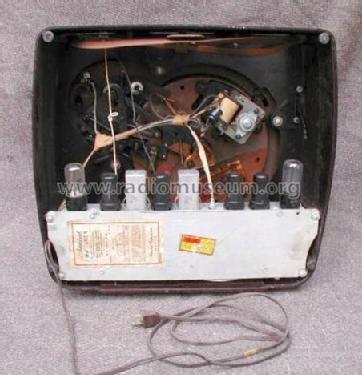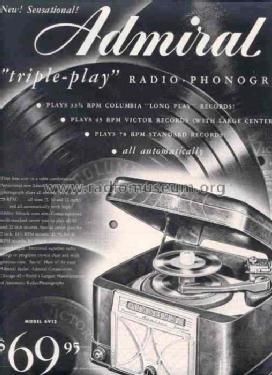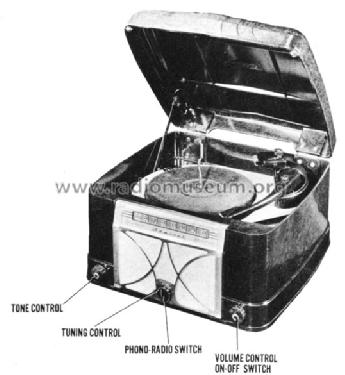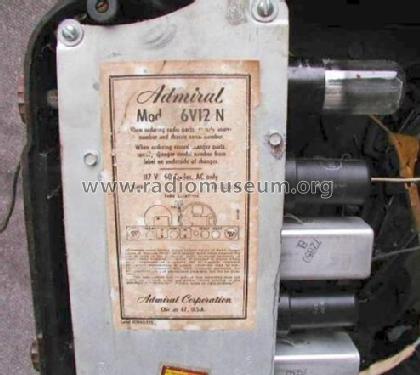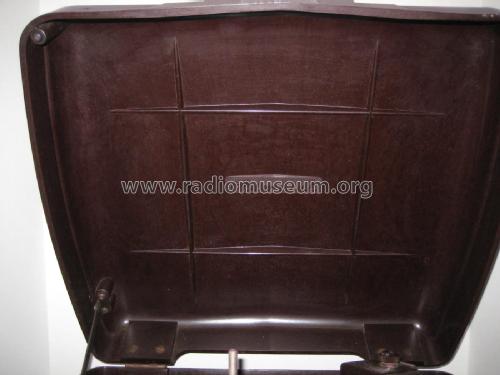- Produttore / Marca
- Admiral (brand) Continental Radio & Television Co.; Chicago, IL
- Anno
- 1949
- Categoria
- Radio (o sintonizzatore del dopoguerra WW2)
- Radiomuseum.org ID
- 31345
-
- alternative name: Continental Radio & TV
Clicca sulla miniatura dello schema per richiederlo come documento gratuito.
- Numero di tubi
- 6
- Principio generale
- Supereterodina (in generale); ZF/IF 455 kHz; 2 Stadi BF
- N. di circuiti accordati
- 6 Circuiti Mod. Amp. (AM)
- Gamme d'onda
- Solo onde medie (OM).
- Particolarità
- Giradischi o cambiadischi
- Tensioni di funzionamento
- Alimentazione a corrente alternata (CA) / 117 Volt
- Altoparlante
- AP magnetodinamico (magnete permanente e bobina mobile)
- Materiali
- Plastica (non bachelite o catalina)
- Radiomuseum.org
- Modello: 6V12 Ch= 6V1 - Admiral brand Continental
- Forma
- Soprammobile con qualsiasi forma (non saputo).
- Annotazioni
- Color=Mahogany
- Fonte esterna dei dati
- Ernst Erb
- Fonte dei dati
- Collector's Guide to Antique Radios 4. Edition
- Riferimenti schemi
- Rider's Perpetual, Volume 20 covering 1950
- Altri modelli
-
In questo link sono elencati 3211 modelli, di cui 1322 con immagini e 2578 con schemi.
Elenco delle radio e altri apparecchi della Admiral (brand) Continental Radio & Television Co.; Chicago, IL
Discussioni nel forum su questo modello: Admiral brand: 6V12 Ch= 6V1
Argomenti: 1 | Articoli: 1
Some is so natural, allthough I would like to remind a methode here, which it used already from the beginning of radio history, particulary maintained in the USA, for a much measuring methode-counted.
In the documents one finds e.g. shown for this Model ADMIRAL 6V12 these informations:
Under the schematic on the left side the table shows the voltage values, the radio is in working condition. On the right side the table shows the resistance values can measured on several pin of the tubes- the radio is unplugged.
.png)
Ω
.png)
I was classified and from there only rarely used this measuring methode with the Ohm meter, but using this procedure is so simply and it is a quick way to find troubles. The resistance examination shows immediately distinctive features. But some conditions have to be respected, e.g. here see the note ..measured from the pin 8 of V6 - this the central point of the positiv DC-voltage supply.
e.g. Tube 12SA 7 is unplugged
Pin 1 n.c. 160kΩ against chassis
Pin 2 heating pin 36Ω against chassis
Pin 3 Anode measuring the sum of R13, R14 and R15 against pin 8 of V6
Pin 4 Grid 4 measuring the sum of R13, R14 and R15 against pin 8 of V6
Pin 5 Grid 1 measuring 22kΩ this is value of R3 against Chassis
Pin 6 Cathode measuring the low impedance of 0.8Ω against - a part of the coil L2
Pin 7 heating pin 24Ω against chassis
Pin 8 Grid 2 measuring 1.3MΩ (app. R5) against Chassis
Checking the voltage conditions this is the next step, but it is more needed to go in details of the schematic.
For the case, some part is broken or in bad condition the value of voltage gives not directly a clear picture of the given fault. Checking the resistance conditions is a quicker methode for trouble shooting.
Allegati
- USA_admiral 6V12 schematic (174 KB)
Friedrich Weber † 12.09.2014, 15.Oct.13








